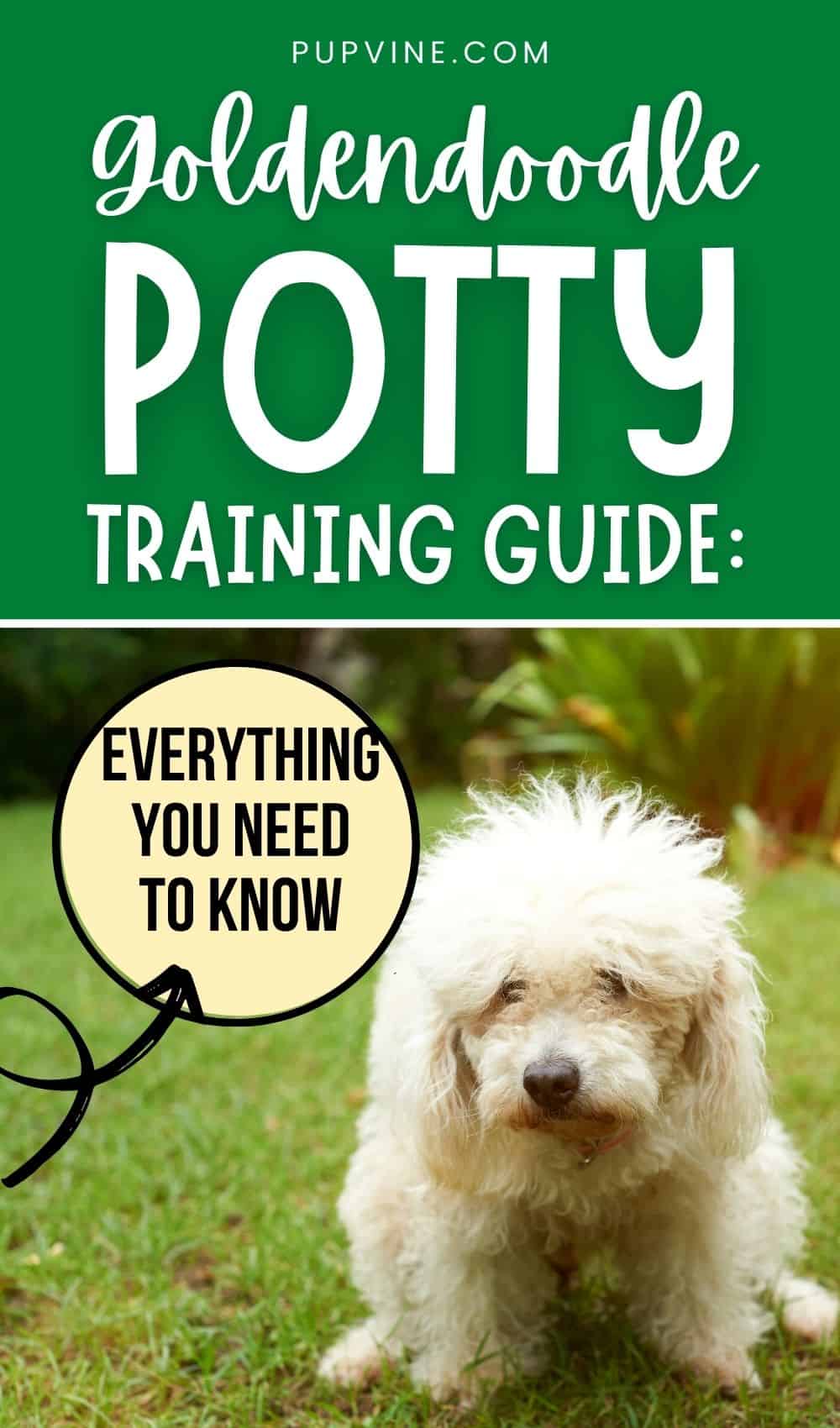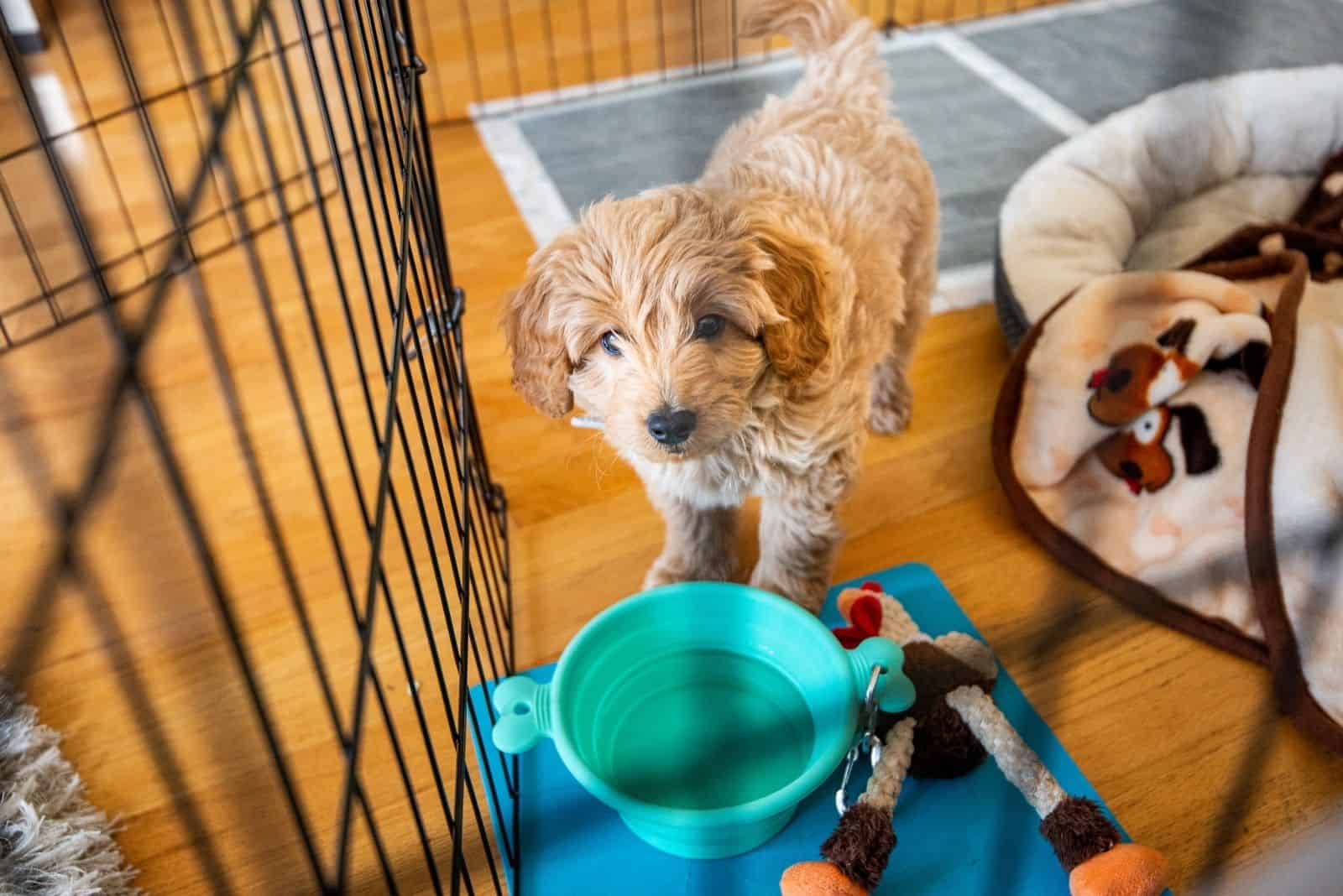Who doesn’t love Goldendoodles?! These adorable Golden Retriever Poodle mixes have quickly become loved worldwide for their fabulous looks and amazing personality.
The problem with cute, small dogs is that many people spoil them, whether intentionally or by accident. While some behaviors can be tolerated, if a dog isn’t potty trained, this can quickly become a mess that’s challenging to ignore.
Goldendoodle potty training has puzzled many dog owners for years. A lot of people think that dogs that are naturally well-behaved and with proper manners don’t require lots of dog training, but this simply isn’t the case.
All dogs need to be trained and socialized. Without proper instructions, dogs will try doing things the way they see fit – which is often not the right way for us.
So what about Goldendoodle potty training?
This is a necessary yet frustrating process that can last for a long while. Many Goldendoodle owners see their puppies as their kids, which creates a lack of understanding that hinders training.
Some even think that the dog will learn this
Still, potty training your Goldendoodle is very much possible. All you need to do is to learn a few tips and tricks. Don’t worry – I’ll explain everything in our step-by-step guide!
Without further ado, here’s all you need to know about Goldendoodle potty training:
Are Goldendoodles Easy To Potty Train?
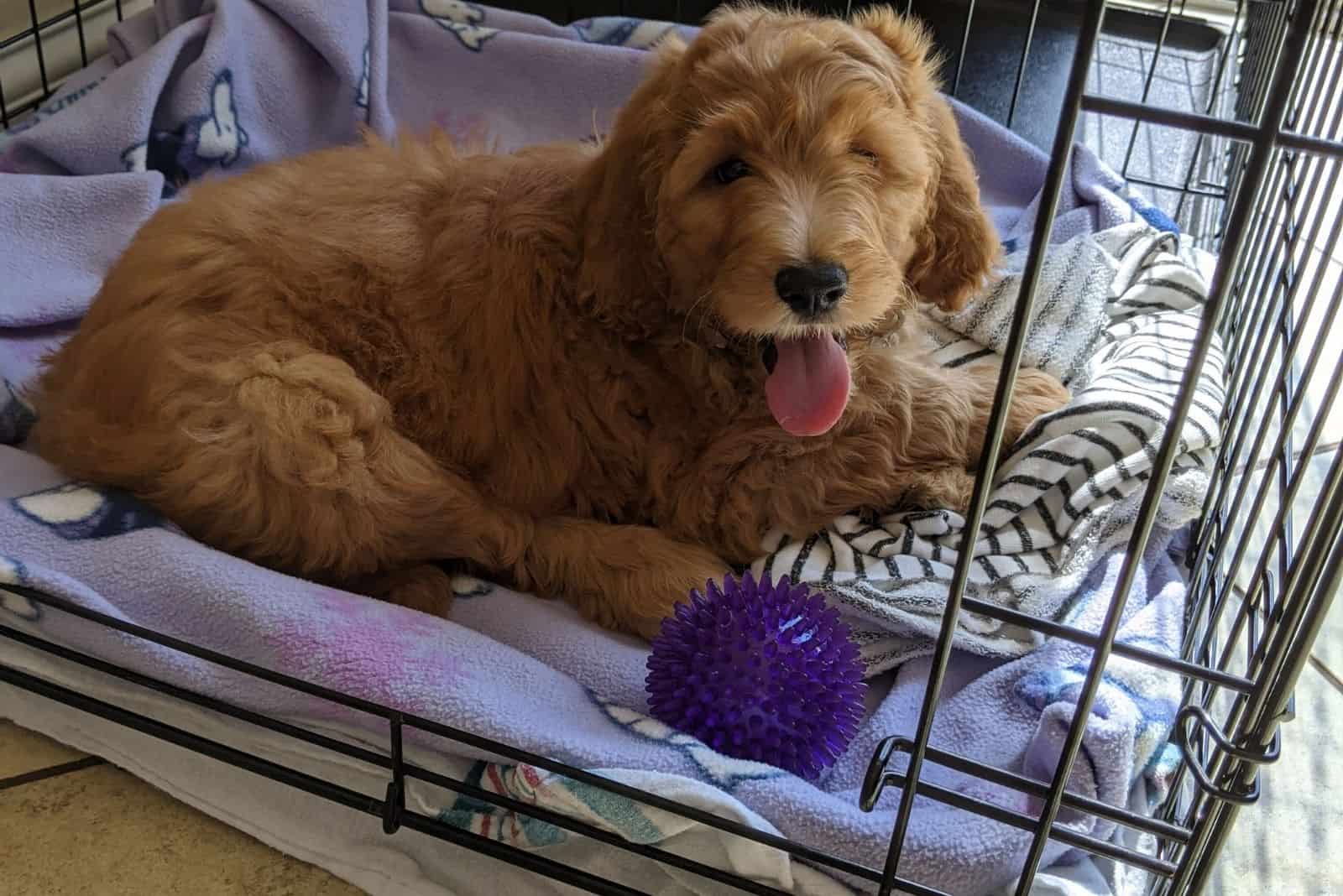
The Goldendoodle isn’t a purebred dog but rather a crossbreed of a purebred Poodle and a purebred Golden Retriever. They are among the most famous Poodle mixes – also known as Doodles.
All Doodles, from Labradoodles to Bernedoodles and Goldendoodles, are known for their good temperament, but what about trainability? To fully understand this, you must first look at the parent dogs.
The Golden Retriever is one of the friendliest dogs you can find. These pups make amazing family dogs due to their ability to love everything and everyone!
They are very eager to please their owners, and they’ll love making you happy – while also being fairly intelligent. All of this means they make great canine companions that will not just learn new tricks easily, but also learn where to go potty.
Poodles, on the other hand, are considered some of the easiest dogs to train. The main reason for this is their high intelligence. In fact, many would argue that Poodles are the most intelligent dog breed out there!
Also, these pups are quite friendly, fun-loving, and eager to do whatever their owner wants. This makes them great dogs when it comes to potty training!
As a combination of the two, Goldendoodles are easy to train. They are high-energy dogs that will love spending time doing activities with their owners, including even chores such as training.
In fact, the biggest reason why there are many Goldendoodles that don’t know where to have a potty break is due to the owner’s mistake.
Many people see adorable Goldendoodles and feel like training them is something cruel or bad. Also, some might think that, due to their kind and intelligent nature, Goldendoodle puppies will teach where to go potty on their own.
While there are always exceptions, this isn’t the case. Goldendoodle potty training is a necessity unless you wish to end with an adult dog that will make lots of mess every single day.
Check out dog breeds that are considered easiest to potty train.
How To Potty Train A Goldendoodle Puppy?
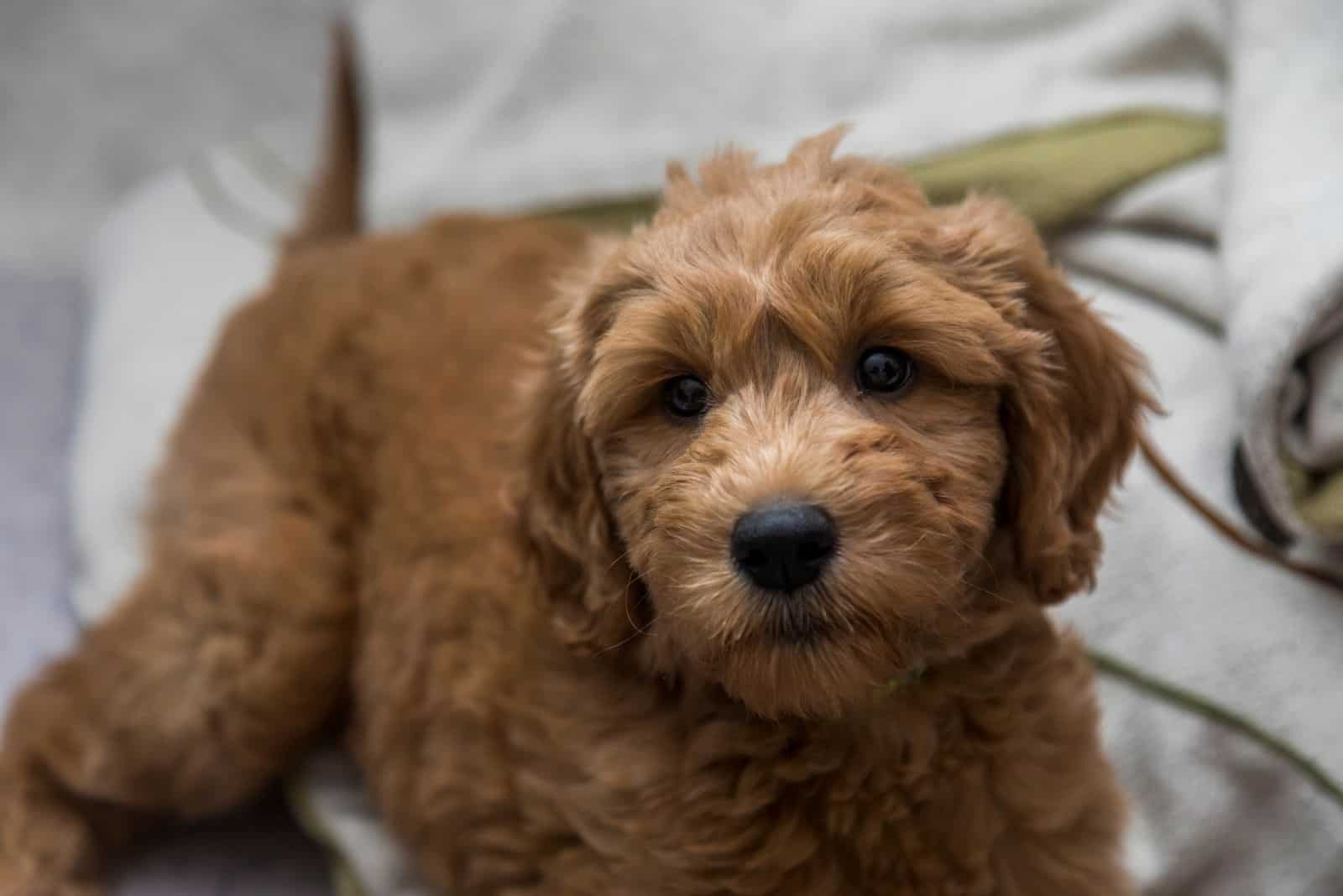
Goldendoodle potty training isn’t a challenging task, even for first-time owners. These are obedient pups that normally won’t trouble you that much.
Some dogs will prefer going outside to potty on their own, but without proper training, they won’t hesitate much to relieve themselves indoors if they feel like it. This is why training is so important.
Here is our step-by-step guide to Goldendoodle potty training:
Step 1: Follow A Schedule
The first thing you should start doing the moment the Goldendoodle puppy arrives in his new home is to establish a strict feeding schedule. Your puppy will need to eat and drink water at a certain time of the day. The potty break should follow immediately.
This one is rather simple to understand. Your puppy will need to go potty after meals. When you monitor your pooch’s food and water intake, you’ll have an idea of when you should take them out for pooping and peeing.
Not all puppies will need to go at the same frequency. This depends on your new puppy’s feeding routine and age. A puppy that is only eight weeks of age will likely need to go more often than a puppy that’s 20 weeks old. This is something you’ll learn on the go.
When you have a strict meal schedule, you can not only predict when it’s time to go out, but your dog will get a sense of when their food will be ready. This means less whining and begging for food.
It’s important to note that this doesn’t mean you should keep a thirsty puppy from drinking. However, you should be aware of the amount of water they drink throughout the day, and when they’re drinking it.
After a short while, you’ll get a proper idea of exactly when your dog will need to go and how long after the meal you can wait.
In general, a Goldendoodle puppy will go to pee short after they’ve had some water.
When it comes to mealtime, young Goldendoodle puppies won’t be able to hold it in for more than ten to 20 minutes after they’ve eaten. They have smaller bladders than adults, and they cannot physically hold them for more than that.
As they grow older, this time frame will be longer. Young Goldendoodles will usually be able to hold it in for half an hour. Most adult dogs won’t have to go for at least an hour.
Keep in mind that each dog is an individual. one puppy might have a slightly faster metabolism than the other one. This is why it’s important to monitor your dog and always keep an eye on him.
Step 2: Restrict Access
As I’ve just mentioned, during Goldendoodle puppy training, you’ll want to keep a close eye on your dog all the time. This might be impossible if your pooch goes to another room.
Not to mention how challenging it might be to find the location of a potty accident if you don’t know which room it happened in!
As such, you should restrict your pup’s access and make sure he stays in one or two rooms all day long. The less room he has to sneak around to, the lower the chances of accidents happening, as you’ll be there to prevent them and correct your pooch.
If for any reason, you cannot close the doors of the room or you cannot restrict access to other spaces, you can always choose to have your dog on a leash.
Yes, dogs can be on a leash inside the house. In fact, this can be a great housebreaking method, and it will also get your puppy used to a leash.
By being on a leash, you’ll know exactly where your Goldendoodle is at any moment. This will also let them know that they cannot hide that they need to go.
Just keep in mind that a dog shouldn’t spend many hours on the leash. Use this method only when you cannot monitor your dog in a standard way.
If your Goldendoodle puppy is close to you, you can easily notice early signs that he needs to do his business.
Some signs that your doggie needs to go include:
• Scratching.
• Circling.
• Sniffing.
• Crotching.
As soon as you notice any of these signs and you know your pup has just finished his meal, you should take your Goldendoodle and carry them outdoors or to the training pad.
I have to mention that very young puppies won’t necessarily show any signs of needing to go. In fact, some pups will only start expressing that they need to pee or poop when they are 16 weeks old.
Step 3: Use A Crate
When you’re not inside the house, it’s time to call for heavy artillery: The crate.
Crate training is a great option for many things. You can use it to help socialization, as it will provide a place your pup can hide in when they no longer want to be around people or dogs.
Also, crate training can be of great help while you’re teaching your new Goldendoodle puppy where they should go potty.
The first step is to make sure you’ve purchased the right size crate. It should be large enough for your Goldendoodle to stand upright and move around a bit. However, it shouldn’t be so big that your dog can be overly active in it.
I know choosing the proper size of a crate is challenging if you have a puppy, but try to make it work.
If not, buy a cheap crate for when they are just a puppy, then get a larger one when they are adults – although I wouldn’t advise this as not all dogs will take too well when they are forced to change their crate.
The goal is to make your dog realize this is his sleeping place. Even young puppies will try to keep themselves from peeing in the same place they sleep on.
This is why it’s essential to choose a crate that is of the right size.
If it’s too small, your dog won’t feel comfortable in it and he’ll get stressed out.
On the other hand, if it’s too big, your pup might decide to use one corner as a sleeping area, and another as a toilet.
Remember that a crate should be your Goldendoodle’s safe space. This isn’t a place to put your dog in as a form of punishment. Your dog needs to know that they can go to their crate when they feel overwhelmed.
Also, you don’t really have to use an actual crate for this step. You can improvise and make a den out of baby gates or even boxes.
The goal is to create a light area your dog cannot get out from, but that they’ll feel safe in. If the ‘crate’ stresses your puppy, don’t force him to stay inside. Otherwise, you’re risking nervous wetting.
A crate can make sure there are no potty accidents during the time you cannot be with your dog.
Step 4: Go Out As Often As Possible
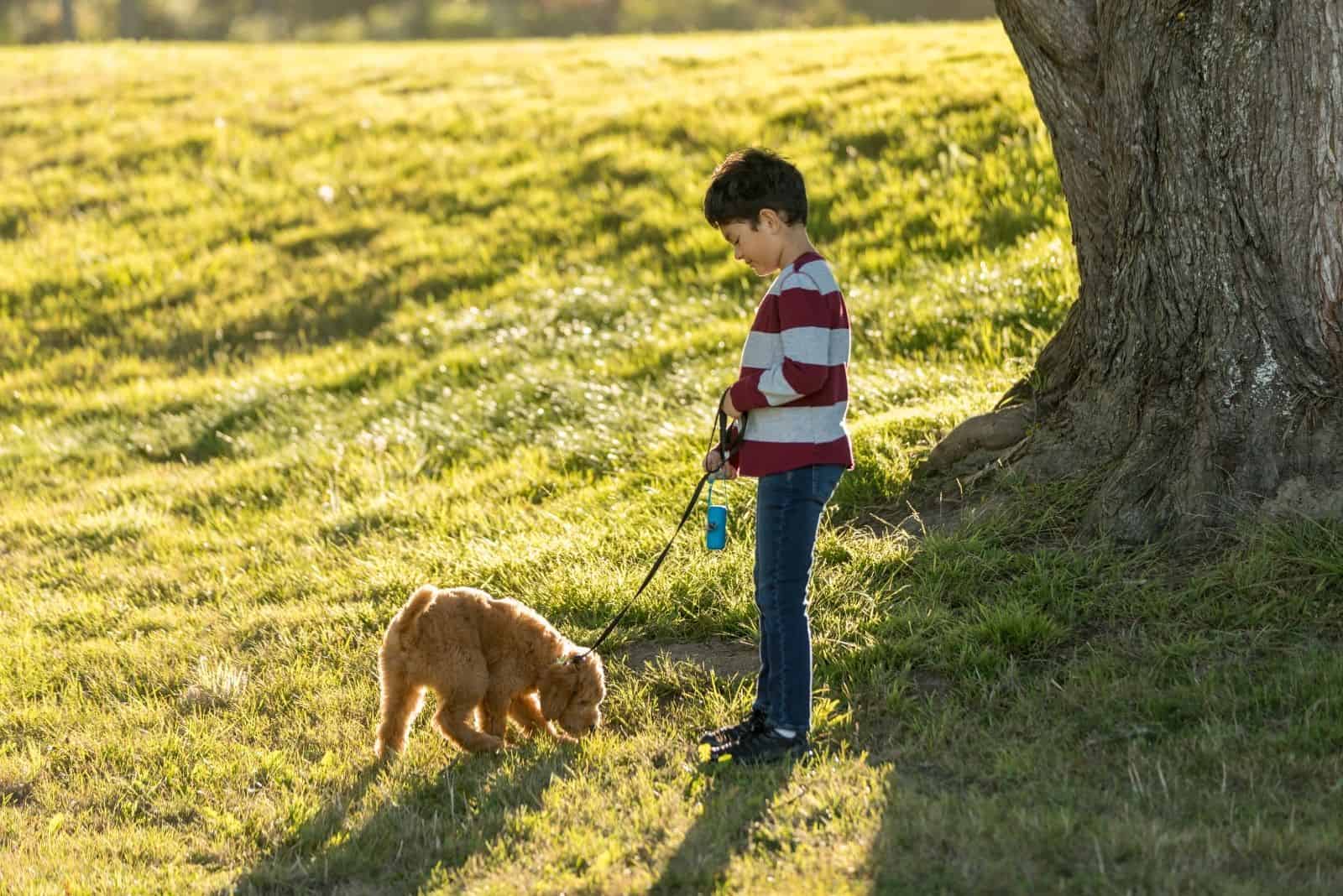
Walking your dog is an important part of being a dog owner, and this is likely something you are prepared for. However, when your new Goldendoodle puppy is still very young, the amount of walking might end up tiring you up.
I know that it’s frustrating having to pause your Netflix series or nap time or even taking a break from your remote work. Still, it’s important to dedicate time to walk your pup as often as possible.
In fact, very young Goldendoodle puppies need to go for a walk every 30 to 45 minutes. Yes, you’ve read that correctly.
A young pup should have to be able to go outside at least every hour. Anything longer than that will greatly increase the chances of accidents.
Don’t worry, you won’t have to keep up this pace for a long while. It’s only to have your Goldendoodle realize they can go outside whenever they feel like it.
Even if you don’t see any sign that your pup needs to go out, don’t risk it – take them out for a few minutes. It doesn’t have to be longer than that. The goal is to have your puppy realize they can do their business whenever they feel like it.
Step 5: Establish Control Words
Whether you’re obedience or house training your pup, you need to establish the exact control words your Goldendoodle will associate with a certain action.
Try to think of something short your dog can easily recognize – for example, Go potty!
Start by excitingly saying Go potty! every time your dog is relieving himself outdoors. This way, they’ll know they are happy, and you’re letting them know by using a certain command.
As you start to notice elimination signs, start saying the command before your Goldendoodle starts relieving himself.
Over time, your pooch will associate the command with elimination, and they’ll get an idea of what it is you want from them.
Step 6: Rewards
Positive reinforcements are likely the best way to get your Goldendoodle (or any other dog, for that matter) to do exactly what you want.
While your Goldendoodle is still a puppy, your best option is to buy some dog treats.
All puppies are extremely food-motivated. While this can fade in adult and older dogs, puppies will do anything to get some food – and what is better than a tasty dog treat from Amazon or your local pet shop?
Even on those rare occasions in which your dog won’t accept the treat as a reward for their good behavior, they’ll be very excited just to know they did something that made you happy. You have to let them know by talking to them cheerfully or by giving them pets and hugs.
Praise your dogs while they are defecating or urinating on the spot you want them to. If you’re using treats, wait until your dog entirely finishes his job before giving the treat to him.
By doing this, you’ll have your dog associate a good thing – the treat – by doing something – peeing outdoors.
Just remember that your dog will associate the last thing they did with the treat. For example, if they pee, then run around, then come for the treat, they’ll think you’re rewarding them for running. This isn’t what you want.
Timing is the key and you need to be careful. Still, this is the most effective method.
Step 7: No Punishments!
While positive reinforcements are a great thing to do, scolding, yelling at, or hitting your Goldendoodle won’t change anything.
Your dog doesn’t comprehend things in the same way you do. They don’t understand what it is you’re scolding them for.
Sure, it’s okay to make a short shout when you notice your dog peeing on the carpet. Just don’t keep yelling and don’t raise your hand on your dog.
Dogs don’t understand punishments. If you punish your dog or hit him, he’ll get scared. This won’t help with potty training – on the contrary.
A dog that is stressed out or afraid might urinate out of fear. Not to mention that this can lead to many bad behaviors or even aggression.
Yes, even Goldendoodles can become aggressive if they’re mistreated, and punishments are a way of improperly dealing with your Goldendoodle’s natural instincts. This is why they are never a good option.
Instead of punishments, stick to positive reinforcements!
Goldendoodle Potty Training Tips
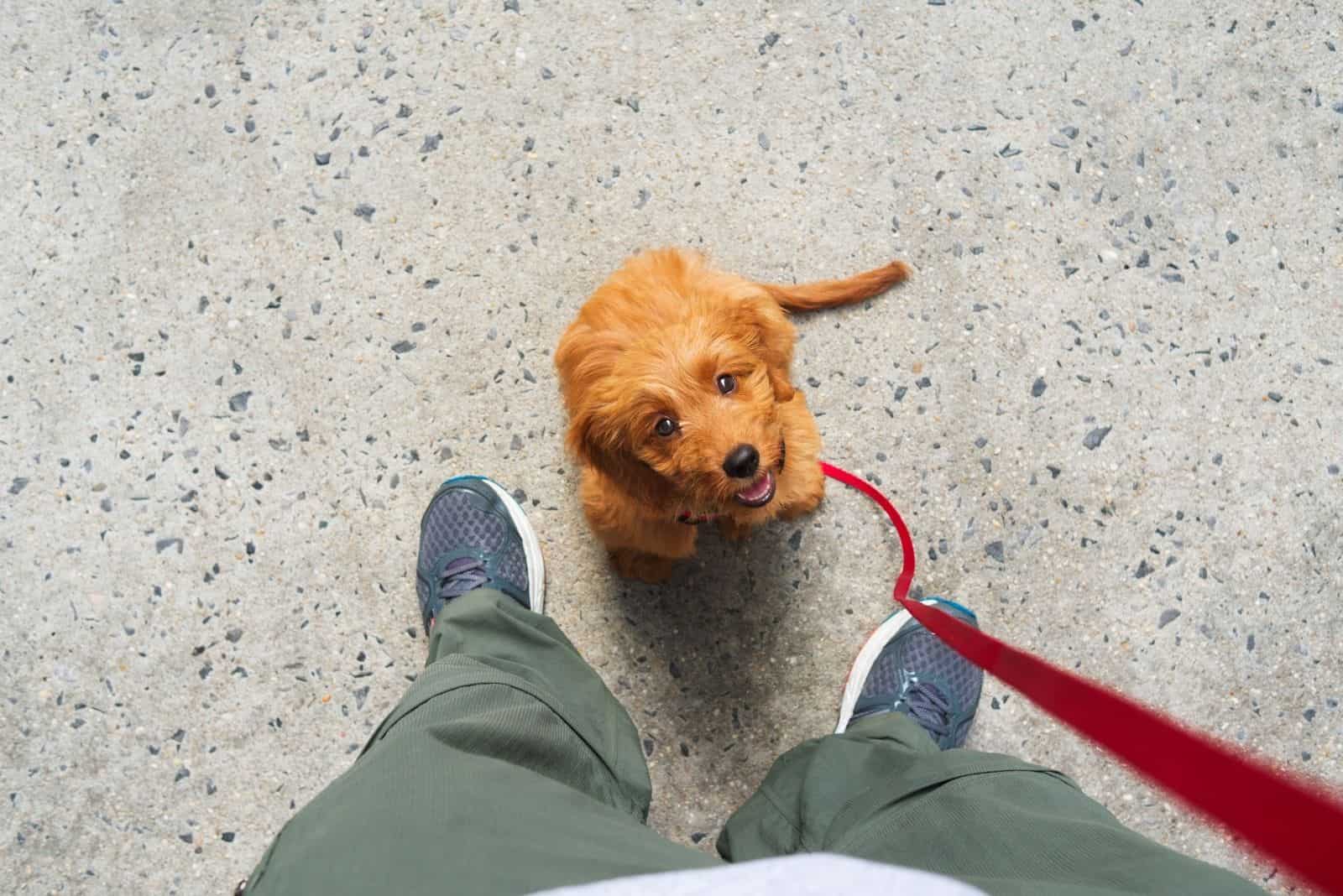
Goldendoodle potty training isn’t the same as other types of obedience training. You’re teaching your Goldendoodle puppy to control its basic needs, something that isn’t easy for humans, let alone dogs.
Still, there are some basic tips and tricks that work for all sorts of training that you should stick to. These can help you get a better connection with your new family member and teach him to pee outside much quicker.
Here’s what they are:
Choose His Name Wisely
Dog’s name matters when it comes to dog training. If a dog’s name is similar sounding to the Go potty! command (or any other basic command, for that matter), your dog will get confused.
Dog’s name is just another command for him. He won’t know this is what he’s called, he’ll simply know that he needs to respond to it in a certain way.
As such, if your Goldendoodle name is too similar to the control word for potty, he might end up not knowing what to do at the time.
As such, avoid names such as Scotty, Marty, or Spotty. Choose some neutral ones instead, such as Teddy, Luna, or Daisy.
Let’s imagine your dog’s name is Scotty. When you call him by his name, he might think it’s time to go outside and for him to do his business.
On the other hand, when you tell him it’s time to go potty, he might think you’re calling him over, and he won’t react appropriately.
Start Young
Starting Goldendoodle puppy training from a young age isn’t always possible, especially if you’ve adopted an older dog.
However, if you’ve purchased from a breeder, I’d assume you’ve gotten yourself a young puppy.
Many dogs that come from reputable breeders, whether we’re talking about mini Goldendoodles or Danoodles, have already undergone some beginner stages of dog training, including potty training. This doesn’t mean you shouldn’t continue with dog training.
The younger the dog and the more consistent the training, the more likely you are to prevent any sort of accidents.
This doesn’t mean you cannot potty train an older dog. It will simply be easier if you’re doing this as soon as possible.
I know, training a little, fluffy puppy can be tough, especially when they’re looking at you with their big, puppy eyes. However, if you let them have their way now, you’ll end up with a large, spoiled dog that will leave a smelly mess wherever he goes!
As such, you should start with potty training the moment your dog enters the house – assuming you’ve bought him when he is eight to 12 weeks old.
Use Training Pads Carefully
Pad training is a useful training method for young dogs that cannot hold it for too long. Training pads are affordable and are easy to clean up.
However, training pads can be counterproductive if your doggie gets so used to them they no longer want to go outside to potty.
As such, once your pup is old enough not to go out every hour or so, I would advise you to use training pads only on occasions when you absolutely have to – for example, when the weather is so bad you cannot take your Goldendoodle outside or if your dog cannot leave the house for a prolonged period of time.
Be Quick
As I’ve mentioned before, the dog’s attention span is short. One moment, your Goldendoodle will be doing his business outside, and the other one, he’ll chase a squirrel.
Rewards are an important part of the training process. However, for them to be effective, you need to reward your pooch at the proper time.
Being a second too late or too early can have consequences that you don’t want.
Give your dog his treat the exact moment he is done with doing his business. If he manages to do anything else in between, he won’t even consider that you’re rewarding him for being a good dog and peeing outside.
The same goes for any other type of training. If your pooch comes when you call him, don’t wait until he starts licking you to give him a treat.
He’ll make a connection between the treat and the licking instead, and this might not be the behavior you want to encourage.
Keep Your Pooch Away From Problem Areas
When a Goldendoodle urinates or pees in a certain spot, it will leave an odor. Even if you cannot smell it, your dog will, and this will make him keep returning to the accident spot.
As such, it’s important to remove these stains with an odor removal spray and not just a regular cleaning solution.
Also, if your dog has a room he prefers for such actions, try keeping him away from it for at least a few months. You can even try to block the problematic area with pieces of furniture.
Either way, you must do all you can to keep your dog from returning to the crime (or rather, potty) scene.
A fun fact: Dogs will prefer urinating on soft surfaces than on wooden, metal, or plastic ones. This is because they don’t want to get splashed while they’re peeing.
If you notice your dog constantly peeing on the living room carpet, try rolling it up once you’ve cleaned it and try not to return it for a little while. This might be enough to let your dog know that the only way he can urinate safely is to go outside.
Be Gentle But Strict
Finally, you need to understand that, while puppies aren’t children, they are still very sensitive.
You mustn’t back down when your doggie gives you a puppy face. The moment you do, your Goldendoodle will know he can get what he wants if he is persistent enough.
At the same time, you shouldn’t yell or push your dog, and you shouldn’t be cold towards him if he had a slip-up.
Goldendoodles are sensitive dogs that will feel your emotions and react according to them. If you are shouting or being angry at them, they’ll sense this and shut down.
When a dog no longer wants to cooperate, it can take you a long while to go back to the point you were at previously.
As such, while you don’t want to give up easily, you also shouldn’t be too harsh on your dog. All canines are good dogs that are always trying their best. They are simply doing it at a different pace than you might expect them to.
How Long Does It Take To Potty Train a Goldendoodle?
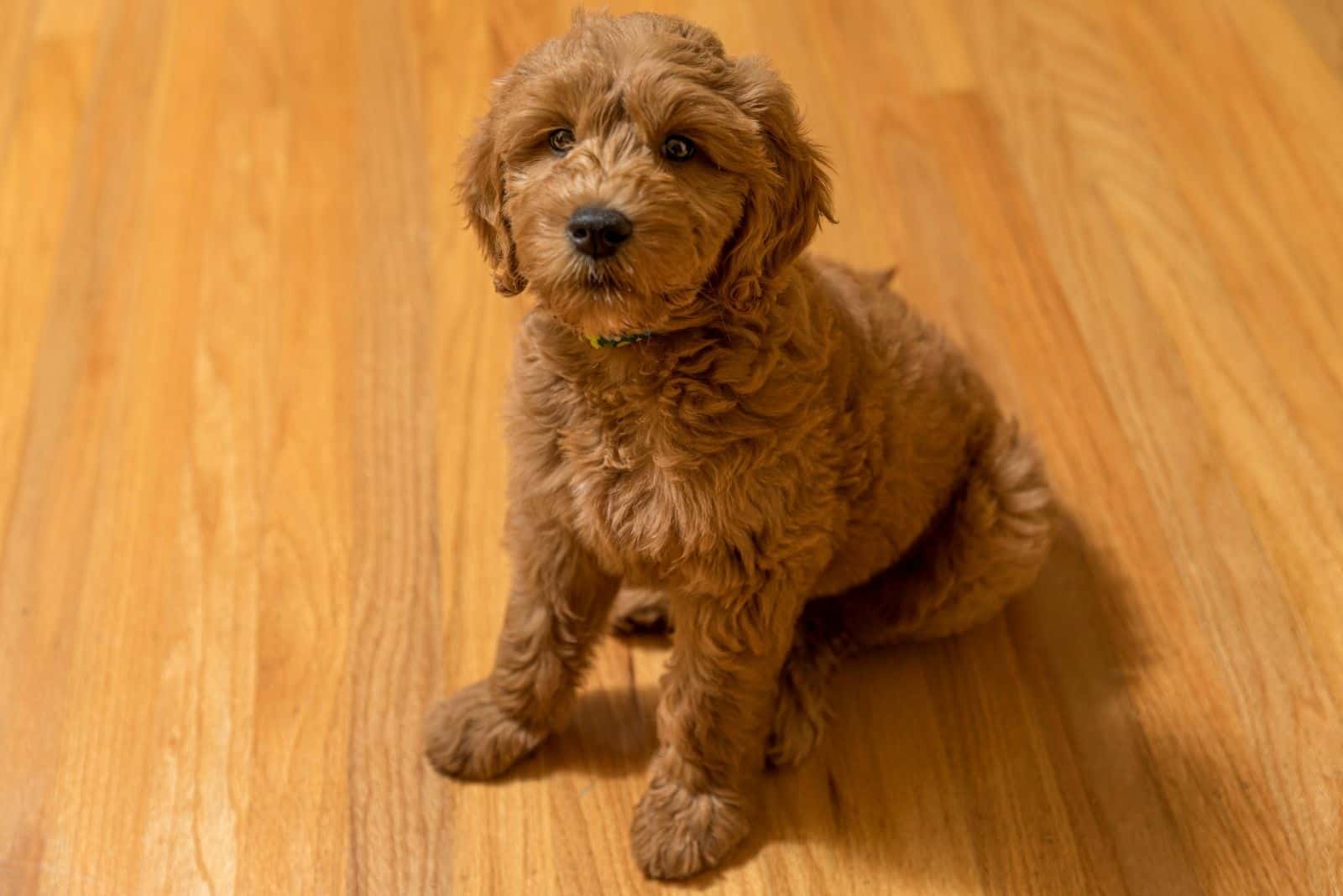
Goldendoodles are fairly easy to potty train, but this doesn’t mean that this is a quick process. In fact, Goldendoodle potty training requires patience, love, and lots of dog treats and tasty puppy food.
Still, it might take four to six months until your Goldendoodle puppy is fully potty trained. This might sound like a lot of time, but it’s important to consider several things that might influence the length of this time frame:
• First and foremost, chances are that your Goldendoodle is very young at the start of his potty training. This means that they cannot physically hold it for a long while.
• Smaller dogs will have smaller bladders. As such, potty training a mini Goldendoodle can take you much longer than potty training a standard one.
• Many dog breeds take up to a year to be fully potty trained.
It’s important to always consider your pup’s physical limitations. Don’t force a Goldendoodle to keep it in for longer than necessary. This will not just stress your pup out, but it might lead to some severe health problems and urinary tract infections.
Goldendoodle Potty Training Problems
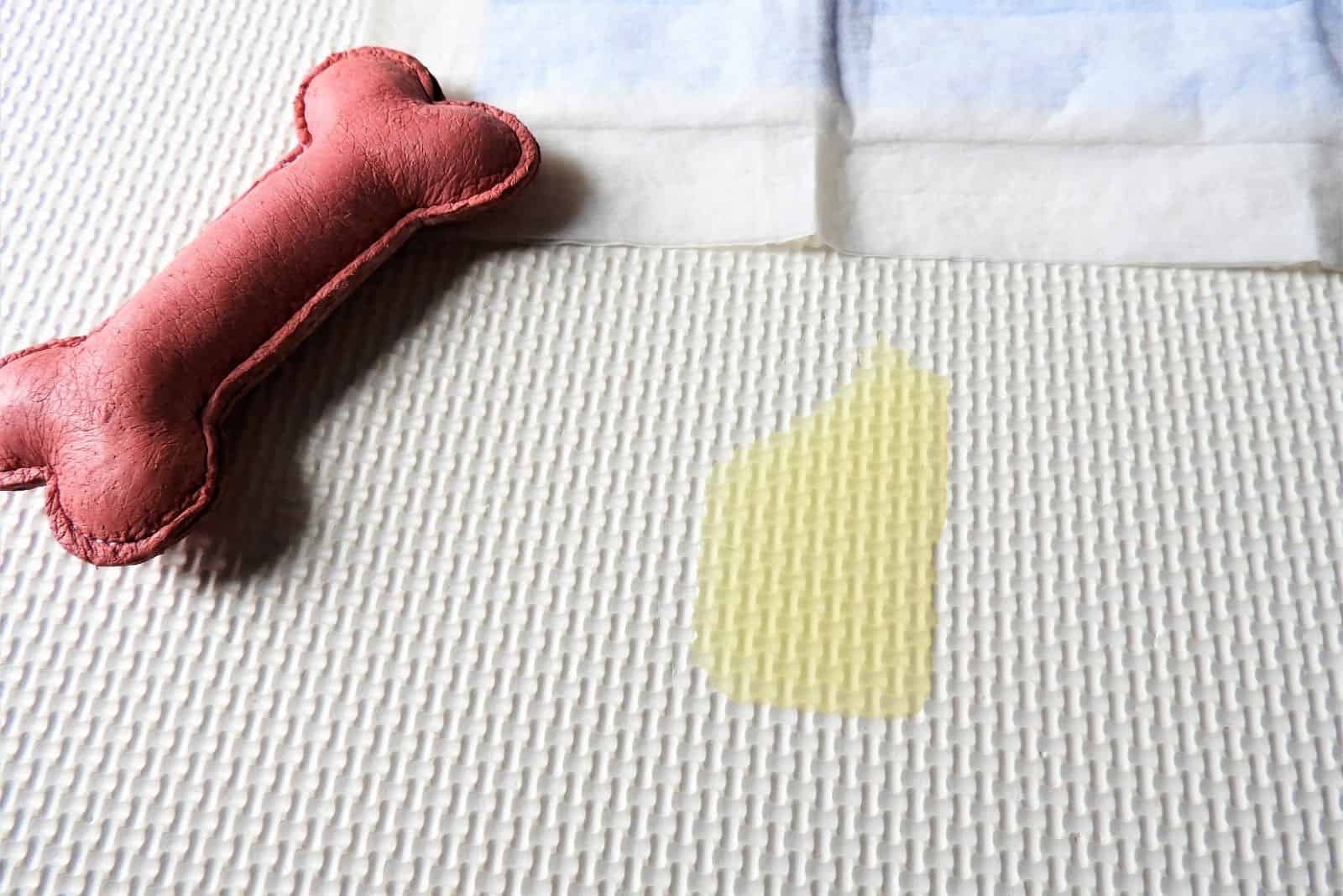
It’s important to keep in mind that accidents can always happen. Even a potty-trained, adult dog might have an accident every now and then.
While you should prevent this behavior, it’s also important to understand it and to deal with it accordingly.
Here are a few reasons why your pooch might still pee when he shouldn’t have, even after all that potty-training you’ve provided him with:
Nervous Wetting
Does your Goldendoodle squat and pee when they are greeting you and your family members? If he is, then he is likely having issues with submissive urination.
Friendly, affectionate dog breeds, such as Goldendoodles or Dachshunds, are prone to submissive urination. They pee as a sign that they are happy to see you and out of the great excitement they are feeling.
At the same time, submissive urination can be a sign of stress or anxiety, especially if they are peeing while standing in the corner.
Dogs that are nervous wetting are usually rather delicate, so you mustn’t yell at them or scold them. If you do so, they might connect yelling with greetings, and they’ll become scared of guests and new people.
One of the ways to do this is to ignore your dog when they are greeting you. This will teach them out of this behavior, lowering the amount of excitement they feel.
If your pooch is already trained, you can command them to sit when people are entering your house or try to distract them. This way, they’ll have something else to do instead of jumping on guests and your family members.
Stress
As mentioned, dogs that are stressed out or anxious might also experience nervous wetting.
Try to think of a reason why your pup might be stressed out. Did you just move into a new house, or buy a new pet? Maybe you’ve just welcomed a new family member, or you’ve started living with your long-term partner.
Sometimes, even the slightest changes, such as changing your dog’s food bowl, can stress a sensitive dog out.
While most Goldendoodles are adaptable, some won’t do that well when changes occur. Any type of environmental change can stress them out and cause them to start nervously wetting.
In fact, nervous wetting due to stress is to be expected whenever you bring a new puppy home. This is a big stress for your dog and he might need to get some relief.
If you’ve adopted a dog from the shelter and he is now having issues with submissive urination, chances are he has been abused and is afraid that the same will happen to him once again.
A young puppy might be stressed out due to teething, which will lower his will to wait before urinating.
A dog might be anxious if you’re stressed out, as well. They can feel their owners’ energy and they’ll respond to it.
Once you’ve figured out what’s stressing your dog, you need to try to remove the stressor or to find a way to desensitize your dog to it.
You might also give your pooch something to keep his mind off the stressors, such as chew toys or taking him to challenging training sessions to keep him tired.
Health Problems
Unfortunately, potty accidents can be connected with a large number of health problems. This can include:
• Urinary tract infection (UTI). While Goldendoodles are not as prone to UTIs as some other dog breeds, they are still the main medical reason behind a dog that’s peeing where he shouldn’t. Your pooch is feeling uncomfortable and simply cannot hold it for as long as he should.
• Urinary or bladder stones. While the symptoms of stones are quite similar to UTIs, these need to be treated with surgery and can have much more severe consequences.
• Incontinence. A dog suffering from urinary incontinence is physically unable to hold his urine.
• Diabetes. Diabetes can cause the dogs to urinate more frequently, as the body needs to get rid of the excess glucose.
• Kidney problems. If the kidneys cannot maintain water, the dog will have to urinate more frequently.
• Cushing’s Disease. This is a progressive disease with symptoms such as excessive thirst, increased appetite, weakness, and frequent urination.
If your dog is potty trained but has suddenly started urinating indoors, you need to contact your vet as soon as possible.
Chances are your dog isn’t disobedient, but rather sick.
Can You Potty Train A Senior Goldendoodle?
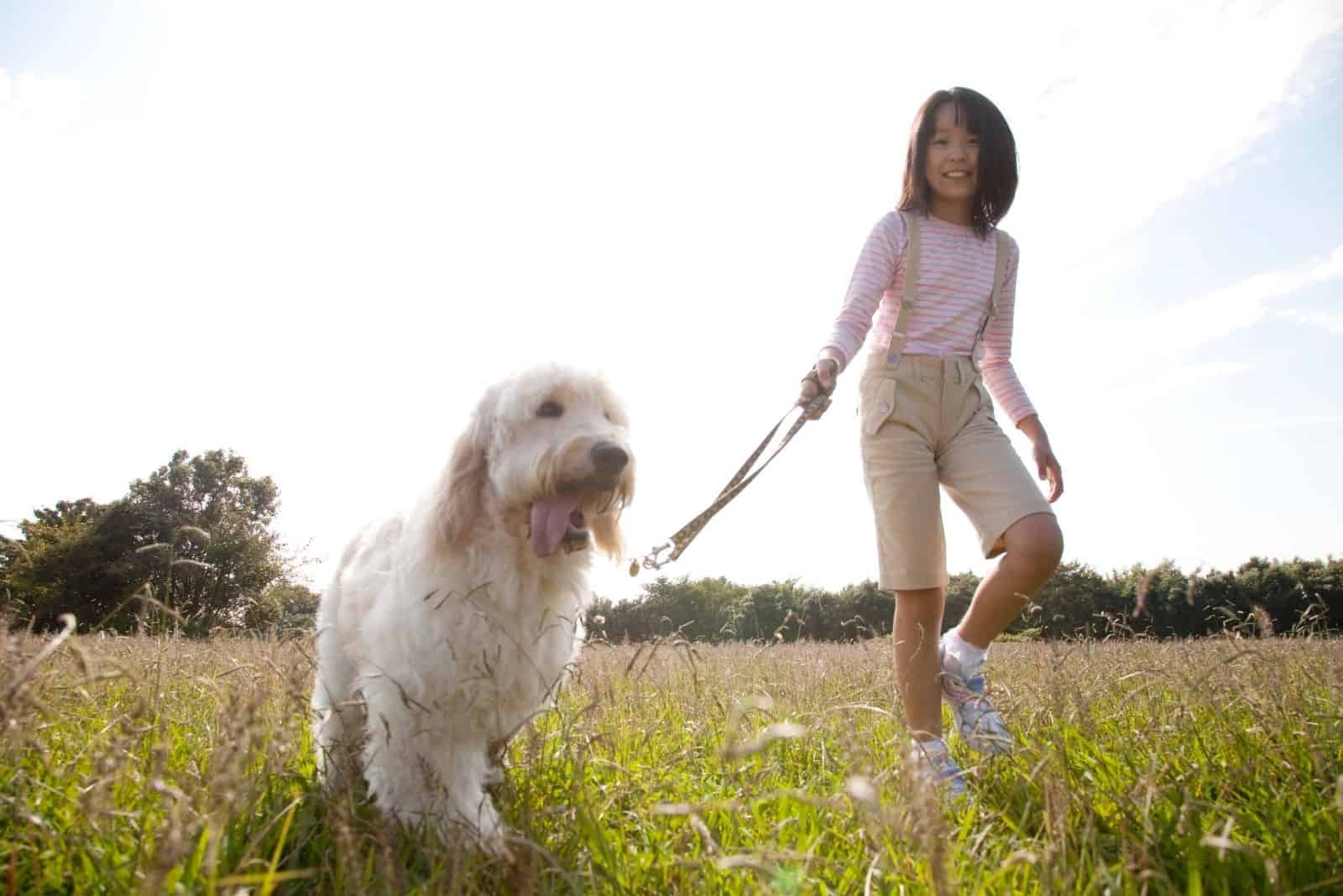
Having an older dog that isn’t potty trained can be rather frustrating. Unfortunately, this is a likely reality when adopting a dog from a shelter that hasn’t been able to get appropriate potty training on time.
Still, believe it or not, it might take you less time to potty train an older dog than to potty train a puppy – as long as we’re not talking about senior dogs that have started to get some health problems associated with aging.
This is because an older dog knows how to control his bladder and bowel movements and can hold it in for a longer time.
The most important thing is to stick to a schedule and to use positive reinforcements. With just a bit of confidence and luck, you’ll be able to have your dog urinate outside in no time.
Why Is Potty Training Important
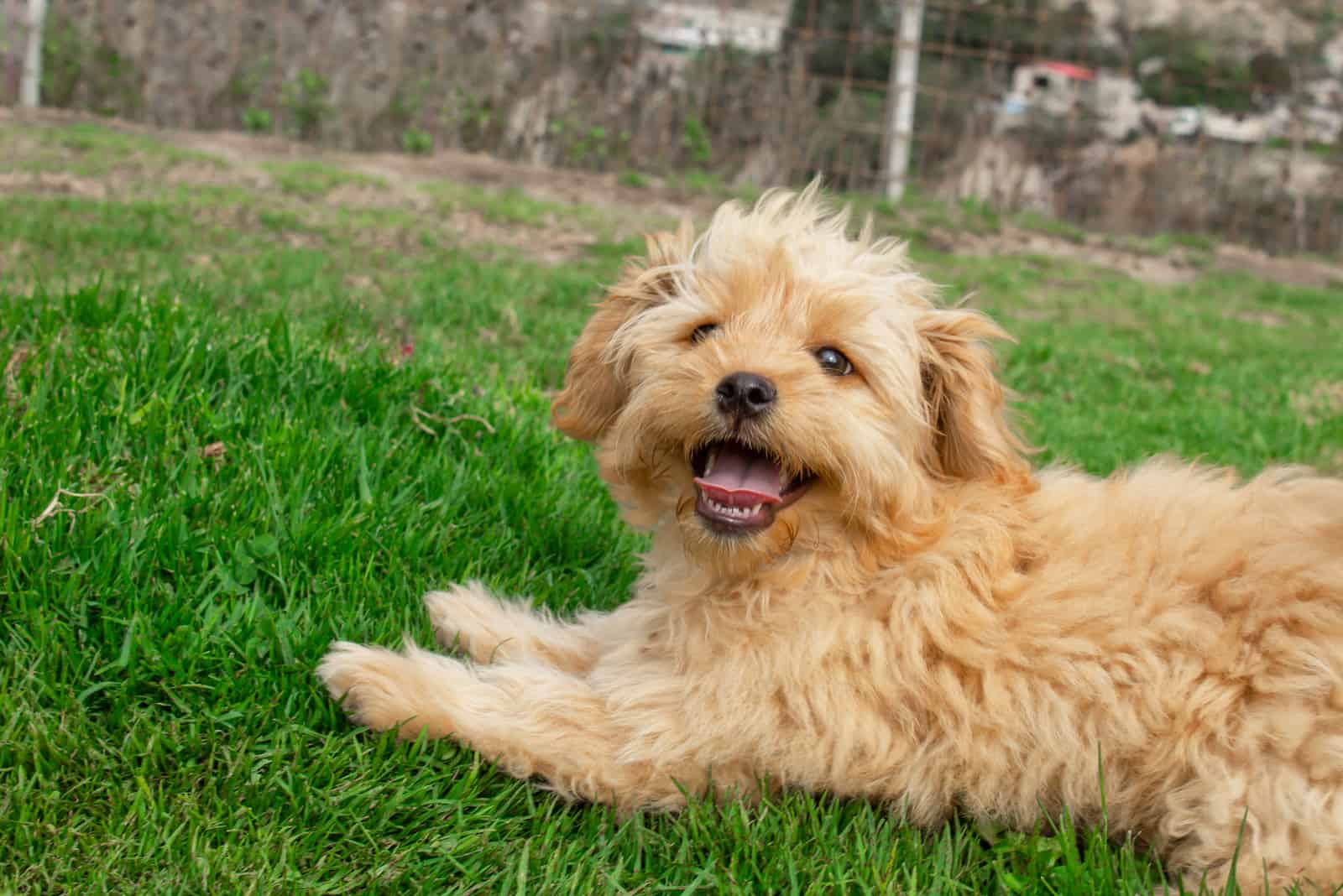
Many people who are not yet dog owners don’t really understand the importance of proper dog training. In their heads, all dogs will simply learn it’s a normal thing they need to do. However, this isn’t something that will happen on its own.
Goldendoodle potty training is easily the most important first step for making sure your dog and you have a happy time together. You don’t need a professional dog trainer for this – it’s enough to arm yourself with some patience.
By teaching your dog where to potty, you’ll also help establish your rule as the alpha dog and the pack leader, something that’s extremely important in any dog ownership.
Luckily for you, Goldendoodles are easy to train and all you’ll need is some understanding and consistency – and a lot of love, as these amazing pups deserve it.
Read Next: Puppy Potty Training Regression: Fixing What’s Broken
